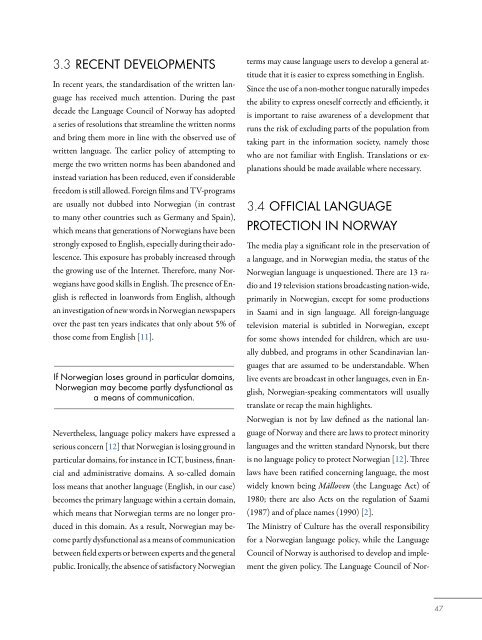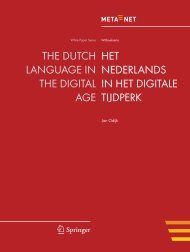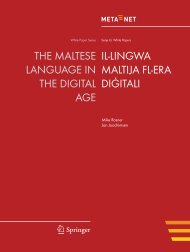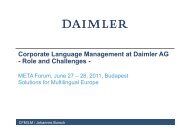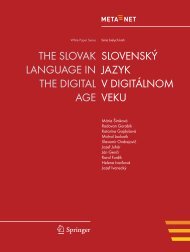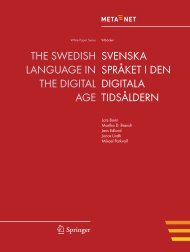Norsk i den digitale tidsalderen - Meta-Net
Norsk i den digitale tidsalderen - Meta-Net
Norsk i den digitale tidsalderen - Meta-Net
You also want an ePaper? Increase the reach of your titles
YUMPU automatically turns print PDFs into web optimized ePapers that Google loves.
3.3 RECENT DEVELOPMENTS<br />
In recent years, the standardisation of the written lan-<br />
guage has received much attention. During the past<br />
decade the Language Council of Norway has adopted<br />
a series of resolutions that streamline the written norms<br />
and bring them more in line with the observed use of<br />
written language. e earlier policy of attempting to<br />
merge the two written norms has been abandoned and<br />
instead variation has been reduced, even if considerable<br />
freedom is still allowed. Foreign films and TV-programs<br />
are usually not dubbed into Norwegian (in contrast<br />
to many other countries such as Germany and Spain),<br />
which means that generations of Norwegians have been<br />
strongly exposed to English, especially during their ado-<br />
lescence. is exposure has probably increased through<br />
the growing use of the Internet. erefore, many Nor-<br />
wegians have good skills in English. e presence of En-<br />
glish is reflected in loanwords from English, although<br />
an investigation of new words in Norwegian newspapers<br />
over the past ten years indicates that only about 5% of<br />
those come from English [11].<br />
If Norwegian loses ground in particular domains,<br />
Norwegian may become partly dysfunctional as<br />
a means of communication.<br />
Nevertheless, language policy makers have expressed a<br />
serious concern [12] that Norwegian is losing ground in<br />
particular domains, for instance in ICT, business, finan-<br />
cial and administrative domains. A so-called domain<br />
loss means that another language (English, in our case)<br />
becomes the primary language within a certain domain,<br />
which means that Norwegian terms are no longer pro-<br />
duced in this domain. As a result, Norwegian may be-<br />
come partly dysfunctional as a means of communication<br />
between field experts or between experts and the general<br />
public. Ironically, the absence of satisfactory Norwegian<br />
terms may cause language users to develop a general at-<br />
titude that it is easier to express something in English.<br />
Since the use of a non-mother tongue naturally impedes<br />
the ability to express oneself correctly and efficiently, it<br />
is important to raise awareness of a development that<br />
runs the risk of excluding parts of the population from<br />
taking part in the information society, namely those<br />
who are not familiar with English. Translations or ex-<br />
planations should be made available where necessary.<br />
3.4 OFFICIAL LANGUAGE<br />
PROTECTION IN NORWAY<br />
e media play a significant role in the preservation of<br />
a language, and in Norwegian media, the status of the<br />
Norwegian language is unquestioned. ere are 13 ra-<br />
dio and 19 television stations broadcasting nation-wide,<br />
primarily in Norwegian, except for some productions<br />
in Saami and in sign language. All foreign-language<br />
television material is subtitled in Norwegian, except<br />
for some shows intended for children, which are usu-<br />
ally dubbed, and programs in other Scandinavian lan-<br />
guages that are assumed to be understandable. When<br />
live events are broadcast in other languages, even in En-<br />
glish, Norwegian-speaking commentators will usually<br />
translate or recap the main highlights.<br />
Norwegian is not by law defined as the national lan-<br />
guage of Norway and there are laws to protect minority<br />
languages and the written standard Nynorsk, but there<br />
is no language policy to protect Norwegian [12]. ree<br />
laws have been ratified concerning language, the most<br />
widely known being Målloen (the Language Act) of<br />
1980; there are also Acts on the regulation of Saami<br />
(1987) and of place names (1990) [2].<br />
e Ministry of Culture has the overall responsibility<br />
for a Norwegian language policy, while the Language<br />
Council of Norway is authorised to develop and imple-<br />
ment the given policy. e Language Council of Nor-<br />
47


